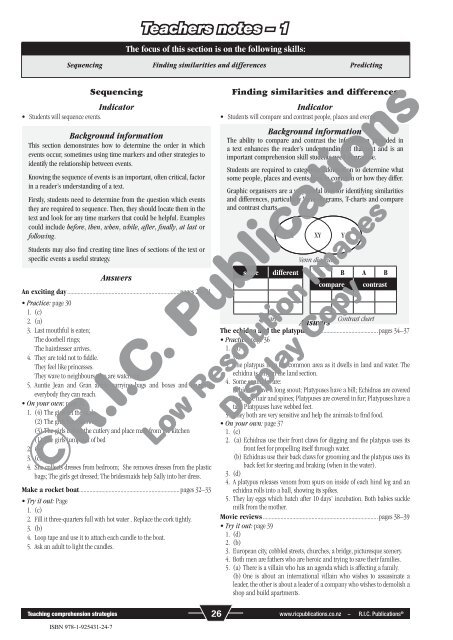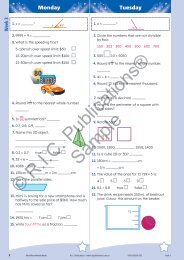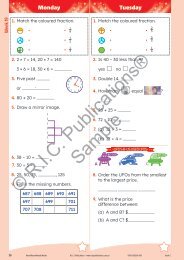NZ-5126 Teaching Comp Strategies (Book F)
Create successful ePaper yourself
Turn your PDF publications into a flip-book with our unique Google optimized e-Paper software.
Teachers notes – 1<br />
The focus of this section is on the following skills:<br />
Sequencing Finding similarities and differences Predicting<br />
Sequencing<br />
Indicator<br />
• Students will sequence events.<br />
Background information<br />
This section demonstrates how to determine the order in which<br />
events occur, sometimes using time markers and other strategies to<br />
identify the relationship between events.<br />
Knowing the sequence of events is an important, often critical, factor<br />
in a reader’s understanding of a text.<br />
Firstly, students need to determine from the question which events<br />
they are required to sequence. Then, they should locate them in the<br />
text and look for any time markers that could be helpful. Examples<br />
could include before, then, when, while, after, finally, at last or<br />
following.<br />
Students may also find creating time lines of sections of the text or<br />
specific events a useful strategy.<br />
Answers<br />
An exciting day.............................................................................pages 28–31<br />
• Practice: page 30<br />
1. (c)<br />
2. (a)<br />
3. Last mouthful is eaten;<br />
The doorbell rings;<br />
The hairdresser arrives.<br />
4. They are told not to fiddle.<br />
They feel like princesses.<br />
They wave to neighbours who are watching.<br />
5. Auntie Jean and Gran arrive carrying bags and boxes and hugging<br />
everybody they can reach.<br />
• On your own: page 31<br />
1. (4) The girls set the table<br />
(2) The girls have showers<br />
(3) The girls collect the cutlery and place mats from the kitchen<br />
(1) The girls jump out of bed<br />
2. (b)<br />
3. (c)<br />
4. She collects dresses from bedroom; She removes dresses from the plastic<br />
bags; The girls get dressed; The bridesmaids help Sally into her dress.<br />
Make a rocket boat....................................................................pages 32–33<br />
• Try it out: Page<br />
1. (c)<br />
2. Fill it three-quarters full with hot water . Replace the cork tightly.<br />
3. (b)<br />
4. Loop tape and use it to attach each candle to the boat.<br />
5. Ask an adult to light the candles.<br />
Finding similarities and differences<br />
Indicator<br />
• Students will compare and contrast people, places and events.<br />
Background information<br />
The ability to compare and contrast the information provided in<br />
a text enhances the reader’s understanding of that text and is an<br />
important comprehension skill students need to practise.<br />
Students are required to categorise information to determine what<br />
some people, places and events have in common or how they differ.<br />
Graphic organisers are a very useful tool for identifying similarities<br />
and differences, particularly Venn diagrams, T-charts and compare<br />
and contrast charts.<br />
same<br />
X<br />
XY<br />
Venn diagram<br />
different A B A B<br />
compare contrast<br />
T-chart<br />
Contrast chart<br />
Answers<br />
The echidna and the platypus................................................pages 34–37<br />
• Practice: page 36<br />
1. (d)<br />
2. (c)<br />
3. The platypus is in the common area as it dwells in land and water. The<br />
echidna is only in the land section.<br />
4. Some examples are:<br />
Echidnas have a long snout; Platypuses have a bill; Echidnas are covered<br />
in coarse hair and spines; Platypuses are covered in fur; Platypuses have a<br />
tail; Platypuses have webbed feet.<br />
5. They both are very sensitive and help the animals to find food.<br />
• On your own: page 37<br />
1. (c)<br />
2. (a) Echidnas use their front claws for digging and the platypus uses its<br />
front feet for propelling itself through water.<br />
(b) Echidnas use their back claws for grooming and the platypus uses its<br />
back feet for steering and braking (when in the water).<br />
3. (d)<br />
4. A platypus releases venom from spurs on inside of each hind leg and an<br />
echidna rolls into a ball, showing its spikes.<br />
5. They lay eggs which hatch after 10 days’ incubation. Both babies suckle<br />
milk from the mother.<br />
Movie reviews...............................................................................pages 38–39<br />
• Try it out: page 39<br />
1. (d)<br />
2. (b)<br />
3. European city, cobbled streets, churches, a bridge, picturesque scenery.<br />
4. Both men are fathers who are heroic and trying to save their families.<br />
5. (a) There is a villain who has an agenda which is affecting a family.<br />
(b) One is about an international villain who wishes to assassinate a<br />
leader, the other is about a leader of a company who wishes to demolish a<br />
shop and build apartments.<br />
Y<br />
<strong>Teaching</strong> comprehension strategies 26 www.ricpublications.co.nz ~ R.I.C. Publications ®<br />
ISBN 978-1-925431-24-7


















